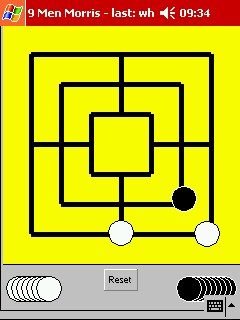Regular polygons
Richard Suchenwirth 2003-02-15 - Regular polygons are convex shapes whose outline consists of straight segments of equal length, with equal angles between adjoining segments. Regular triangles and squares are simple examples. All corners of a r.p. are on a circle.
Talking of circles, one bug of the Tk 8.4a2/WinCE port for the iPAQ is that oval canvas items (which in an enclosing square make circles) are not implemented, making porting things like Nine Men Morris or trains3.tcl a bit hard. I have no doubt that this will be fixed in later releases, but "I want it now"... Hence the following workaround to approximate ovals with polygons - just replace commands like
$c create oval 0 0 50 50 ...
with
$c create poly [rp 0 0 50 50] ...
where the rp function below computes a sequence of polygon points, starting at top center, that approximate an oval on the given enclosing rectangle - regular if it's a square, but also oblongly distorted for non-square rectangles, just as oval objects go. The degree (number of corners) may be specified as fifth argument, but defaults to a number which makes quite nice circles, e.g. 15 for a square side of 30 pixels.
With this workaround in place, I could make a reasonable port of Nine Men Morris to the iPAQ. Dragging the men around is a bit slow in reaction (and risks scratches on the little touch screen), and I had to disable the snap-in-place code, but still it's a nice addition to the games collection ;-)
KPV How about generalizing this to work as a replacement for the arc command? KPV I just went and did it, see Regular Polygons 2.
proc rp {x0 y0 x1 y1 {n 0}} { set xm [expr {($x0+$x1)/2.}] set ym [expr {($y0+$y1)/2.}] set rx [expr {$xm-$x0}] set ry [expr {$ym-$y0}] if {$n==0} { set n [expr {round(($rx+$ry)*0.5)}] } set step [expr {atan(1)*8/$n}] set res "" set th [expr {atan(1)*6}] ;#top for {set i 0} {$i<$n} {incr i} { lappend res \ [expr {$xm+$rx*cos($th)}] \ [expr {$ym+$ry*sin($th)}] set th [expr {$th+$step}] } set res }
Finally, a demo as usual, which shows regular 3..8-gons and a circle approximated as a 15-gon:
if {[file tail [info script]]==[file tail $argv0]} { pack [canvas .c -width 240 -height 40] set x 0 set x1 32 foreach n {3 4 5 6 7 8 0} { .c create poly [rp $x 2 $x1 34 $n] -fill red -outline black incr x 34; incr x1 34 } }
See Traffic lights for another use.
HJG There are bugs hiding in the above calculation of n, which cause divide by zero:
# !! Bugs: .c create poly [rp 250 12 250 12 0] -fill blue -outline black .c create poly [rp 240 34 272 2 0] -fill cyan -outline black
The calculation doesn't handle zero radius circles or reversed coordinates
if {$n==0} { set n [expr {round((abs($rx)+abs($ry))*0.5)}] ;# handle reversed coordinates if {$n==0} {set n 1} ;# handle zero radius circles }

